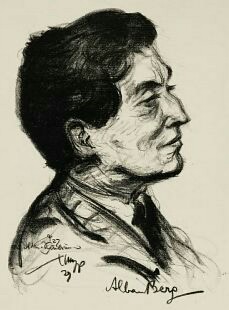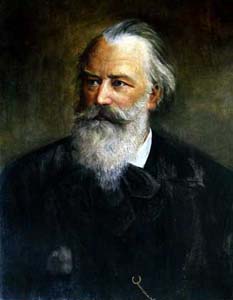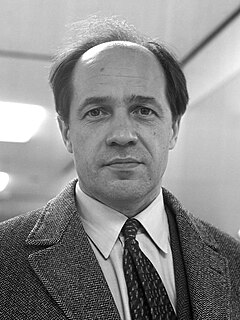In music, a tone row or note row, also series or set, is a non-repetitive ordering of a set of pitch-classes, typically of the twelve notes in musical set theory of the chromatic scale, though both larger and smaller sets are sometimes found.
In music, serialism is a method of composition using series of pitches, rhythms, dynamics, timbres or other musical elements. Serialism began primarily with Arnold Schoenberg's twelve-tone technique, though some of his contemporaries were also working to establish serialism as a form of post-tonal thinking. Twelve-tone technique orders the twelve notes of the chromatic scale, forming a row or series and providing a unifying basis for a composition's melody, harmony, structural progressions, and variations. Other types of serialism also work with sets, collections of objects, but not necessarily with fixed-order series, and extend the technique to other musical dimensions, such as duration, dynamics, and timbre.

The twelve-tone technique—also known as dodecaphony, twelve-tone serialism, and twelve-note composition—is a method of musical composition first devised by Austrian composer Josef Matthias Hauer, who published his "law of the twelve tones" in 1919. In 1923, Arnold Schoenberg (1874–1951) developed his own, better-known version of 12-tone technique, which became associated with the "Second Viennese School" composers, who were the primary users of the technique in the first decades of its existence. The technique is a means of ensuring that all 12 notes of the chromatic scale are sounded as often as one another in a piece of music while preventing the emphasis of any one note through the use of tone rows, orderings of the 12 pitch classes. All 12 notes are thus given more or less equal importance, and the music avoids being in a key. Over time, the technique increased greatly in popularity and eventually became widely influential on 20th-century composers. Many important composers who had originally not subscribed to or actively opposed the technique, such as Aaron Copland and Igor Stravinsky, eventually adopted it in their music.

Alban Berg's Violin Concerto was written in 1935. It is probably Berg's best-known and most frequently performed instrumental piece, in which the composer sought to reconcile diatonicism and dodecaphony. Berg composed it on a commission from Louis Krasner, and it became the last work that he completed. Krasner performed the solo part in the premiere at the Palau de la Música Catalana, Barcelona on 19 April 1936, after the composer's death.
In music using the twelve tone technique, combinatoriality is a quality shared by twelve-tone tone rows whereby each section of a row and a proportionate number of its transformations combine to form aggregates. Much as the pitches of an aggregate created by a tone row do not need to occur simultaneously, the pitches of a combinatorially created aggregate need not occur simultaneously. Arnold Schoenberg, creator of the twelve-tone technique, often combined P-0/I-5 to create "two aggregates, between the first hexachords of each, and the second hexachords of each, respectively."

Catherine Anahid "Cathy" Berberian was an American mezzo-soprano and composer based in Italy. She worked closely with many contemporary avant-garde music composers, including Luciano Berio, Bruno Maderna, John Cage, Henri Pousseur, Sylvano Bussotti, Darius Milhaud, Roman Haubenstock-Ramati, and Igor Stravinsky. She also interpreted works by Claudio Monteverdi, Heitor Villa-Lobos, Kurt Weill, Philipp Zu Eulenburg and others. As a recital curator, she presented several vocal genres in a classical context, including arrangements of songs by The Beatles as well as folk songs from several countries and cultures. As a composer, she wrote Stripsody (1966), in which she exploits her vocal technique using comic book sounds (onomatopoeia), and Morsicat(h)y (1969), a composition for the keyboard based on Morse code.

Bruno Maderna was an Italian conductor and composer.

The Clarinet Sonatas, Op. 120, Nos. 1 and 2, are a pair of works written for clarinet and piano by the Romantic composer Johannes Brahms. They were written in 1894 and are dedicated to the clarinetist Richard Mühlfeld. The sonatas stem from a period late in Brahms's life where he “discovered” the beauty of the sound and tonal colour of the clarinet. The form of the clarinet sonata was largely undeveloped until after the completion of these sonatas, after which the combination of clarinet and piano was more readily used in composers’ new works. These were the last chamber pieces Brahms wrote before his death and are considered two of the great masterpieces in the clarinet repertoire. Brahms also produced a frequently performed transcription of these works for viola with alterations to better suit the instrument.

Darmstadt School refers to a group of composers who were associated with the Darmstadt International Summer Courses for New Music from the early 1950s to the early 1960s in Darmstadt, Germany, and who shared some aesthetic attitudes. Initially, this included only Pierre Boulez, Bruno Maderna, Luigi Nono, and Karlheinz Stockhausen, but others came to be added, in various ways. The term does not refer to an educational institution.
Gruppen for three orchestras (1955–57) is amongst the best-known compositions of German composer Karlheinz Stockhausen, and is Work Number 6 in the composer's catalog of works. Gruppen is "a landmark in 20th-century music. .. probably the first work of the post-war generation of composers in which technique and imagination combine on the highest level to produce an undisputable masterpiece".

Rituel in memoriam Bruno Maderna (1974–75) is a composition for orchestra in eight groups by Pierre Boulez. Biographer Dominique Jameux wrote that the piece has "obvious audience appeal", and that it represented a desire to establish "immediate, almost physical contact with the public". Jameux also noted that Rituel represents one of the few examples of repetitive music written by Boulez. Author Jonathan Goldman wrote that, of Boulez's works, Rituel is the one that "most evokes... the sound worlds of non-Western musical ensembles, be they Indonesian, African or South American."
Punctualism is a style of musical composition prevalent in Europe between 1949 and 1955 "whose structures are predominantly effected from tone to tone, without superordinate formal conceptions coming to bear". In simpler terms: "music that consists of separately formed particles—however complexly these may be composed—[is called] punctual music, as opposed to linear, or group-formed, or mass-formed music", bolding in the source). This was accomplished by assigning to each note in a composition values drawn from scales of pitch, duration, dynamics, and attack characteristics, resulting in a "stronger individualizing of separate tones". Another important factor was maintaining discrete values in all parameters of the music. Punctual dynamics, for example
mean that all dynamic degrees are fixed; one point will be linked directly to another on the chosen scale, without any intervening transition or gesture. Line-dynamics, on the other hand, involve the transitions from one given amplitude to another: crescendo, decrescendo and their combinations. This second category can be defined as a dynamic glissando, comparable to glissandi of pitch and of tempi.
Sequenza IV for solo piano is the fourth in a series of solo Sequenze by Luciano Berio that started with the publication of Sequenza I for solo flute.

Sinfonia (Symphony) is a composition by the Italian composer Luciano Berio which was commissioned by the New York Philharmonic for its 125th anniversary. Composed in 1968–69 for orchestra and eight amplified voices, it is a musically innovative post-serial classical work, with multiple vocalists commenting about musical topics as the piece twists and turns through a seemingly neurotic journey of quotations and dissonant passages. The eight voices are not used in a traditional classical way; they frequently do not sing at all, but speak, whisper and shout words by Claude Lévi-Strauss, whose Le cru et le cuit provides much of the text, excerpts from Samuel Beckett's novel The Unnamable, instructions from the scores of Gustav Mahler and other writings.
Anton Webern's Concerto for Nine Instruments, Op. 24, Op. 24, written in 1934, is a twelve-tone concerto for nine instruments: flute, oboe, clarinet, horn, trumpet, trombone, violin, viola, and piano. It consists of three movements:
In music, the "Ode-to-Napoleon" hexachord is the hexachord named after its use in the twelve-tone piece Ode to Napoleon Buonaparte (1942) by Arnold Schoenberg. Containing the pitch-classes 014589 it is given Forte number 6–20 in Allen Forte's taxonomic system. The primary form of the tone row used in the Ode allows the triads of G minor, E♭ minor, and B minor to easily appear.

Luciano Berio OMRI was an Italian composer noted for his experimental work, and for his pioneering work in electronic music. His early work was influenced by Igor Stravinsky and experiments with serial and electronic techniques, while his later works explore indeterminacy and the use of spoken texts as the basic material for composition.
Scambi (Exchanges) is an electronic music composition by the Belgian composer Henri Pousseur, realized in 1957 at the Studio di fonologia musicale di Radio Milano.
A–Ronne is a tape composition for five voice actors by the Italian composer Luciano Berio.








